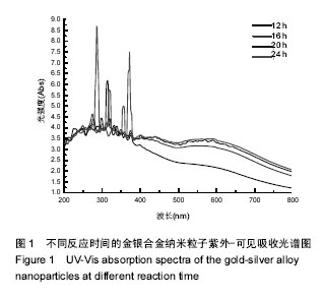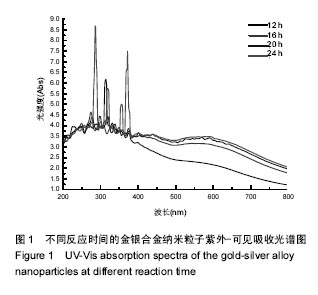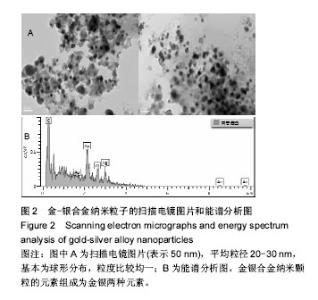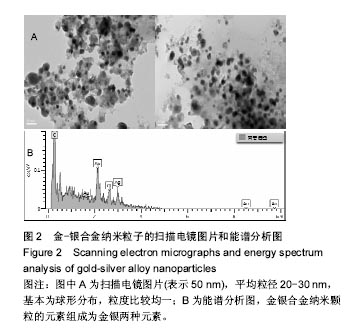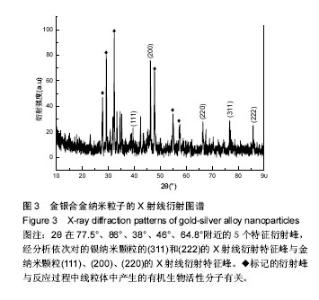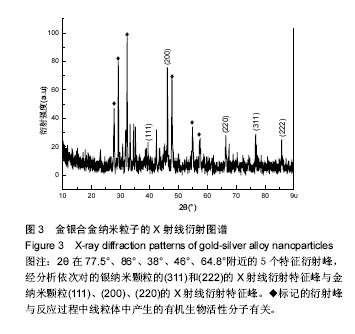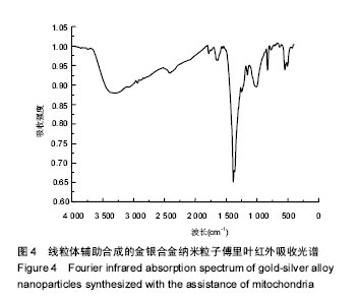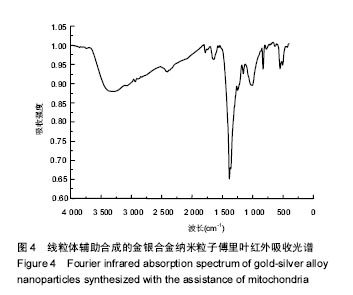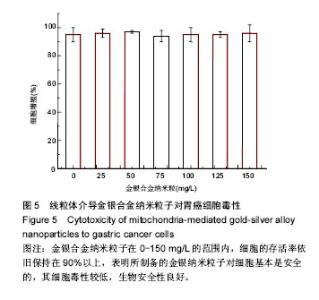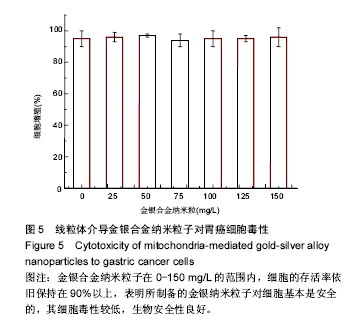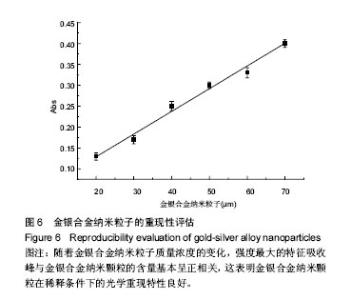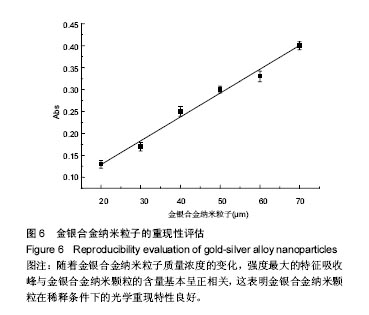Chinese Journal of Tissue Engineering Research ›› 2018, Vol. 22 ›› Issue (2): 222-227.doi: 10.3969/j.issn.2095-4344.0010
Previous Articles Next Articles
Mitochondria-mediated synthesis of gold-silver alloy nanoparticles
- Institute of Applied Mechanics and Biomedical Engineering, Taiyuan University of Technology, Taiyuan 030024, Shanxi Province, China
-
Received:2017-08-22Online:2018-01-18Published:2018-01-18 -
Contact:Chen Wei-yi, M.D., Professor, Doctoral supervisor, Institute of Applied Mechanics and Biomedical Engineering, Taiyuan University of Technology, Taiyuan 030024, Shanxi Province, China -
About author:Meng Biao, Master, Institute of Applied Mechanics and Biomedical Engineering, Taiyuan University of Technology, Taiyuan 030024, Shanxi Province, China -
Supported by:the National Natural Science Foundation of China, No. 81602506; the Innovative Program of Shanxi High Educations, No. 2016143
CLC Number:
Cite this article
Meng Biao, Chen Wei-yi, Zhang Yi-xia, Wen Xu-dong, Li Kai .
share this article
Add to citation manager EndNote|Reference Manager|ProCite|BibTeX|RefWorks
| [1]Huang J,Wang W,Lin L,et al.A general strategy for the biosynthesis of gold nanoparticles by traditional Chinese medicines and their potential application as catalysts.Chem Asian J. 2009;4(7):1050-1054.[2]Ray PC,Darbha GK,Ray A,et al.A gold-nanoparticle-based fluorescence resonance energy transfer probe for multiplexed hybridization detection: accurate identification of bio-agents DNA. Nanotechnology.2007;18:1-6.[3]Schwartzberg AM,Grant CD,Wolcott A,et al.Unique gold nanoparticle aggregates as a highly active surface-enhanced Raman scattering substrate.J Phys Chem B. 2004;108(50): 19191-19197.[4]Pissuwan D,Niidome T,Cortie MB.The forthcoming applications of gold nanoparticles in drug and gene delivery systems.J Controlled Release.2011;149(1):65.[5]Boisselier E,Astruc D.Gold nanoparticles in nanomedicine: preparations, imaging, diagnostics, therapies and toxicity. Chem Soc Rev.2009;38(6):1759-1782. [6]Li Z,Huang P,Zhang X,et al.RGD-Conjugated Dendrimer-Modified Gold Nanorods for in Vivo Tumor Targeting and Photothermal Therapy.Mol Pharm.2009;7(1):94-104. [7]Chen DH,Chen CJ.Formation and characterization of Au–Ag bimetallic nanoparticles in water-in-oil microemulsions.J Mater Chem.2002;12(5):1557-1562.[8]Papavassiliou GC.Surfaceplasmons in small Au-Ag alloy particles.J Phys Metal Phys.1976;6(4):L103.[9]Link S,Wang ZL,El-Sayed MA.Alloy formation of gold-silver nanoparticles and the dependence of the plasmon absorption on their composition.J Phys Chem B.1999;103(18): 3529-3533.[10]Shankar SS,Ahmad A,Pasricha R,et al.Bioreduction of chloroaurate ions by geranium leaves and its endophytic fungus yields gold nanoparticles of different shapes.J Mater Chem.2003;13(7):1822-1826.[11]Shankar S,Ahmad A,Sastry M.Geranium leaf assisted biosynthesis of silver nanoparticles. Biotechnol Prog. 2003; 19(6):1627-1631.[12]Narayanan KB,Sakthivel N.Phytosynthesis of gold nanoparticles using leaf extract of Coleus amboinicusLour.Mater Charact.2010;61:1232-1238.[13]Faramarzi MA,Forootanfar H.Biosynthesis and characterization of gold nanoparticles produced by laccase from Paraconiothyriumvariabile.Colloids Surf B Biointerfaces. 2011;87(1):23-27.[14]Philip D.Honey mediated green synthesis of gold nanoparticles.Spectrochim Acta A Mol Biomol Spectrosc. 2009;73(4):650-653. [15]Nune SK,Chanda N,Shukla R,et al.Green nanotechnology from tea: phytochemicals in tea as building blocks for production of biocompatible gold nanoparticles.J Mater Chem.2009;19(19):2912-2920.[16]Katz E,Willner I,Wang J.Electroanalytical and bioelectroanalytical systems based on metal and semiconductor nanoparticles.Electroanalysis. 2004;16(1-2): 19-44.[17]Tisch U,Haick H.Arrays of chemisensitive monolayer-capped metallic nanoparticles for diagnostic breath testing.Rev Chem Eng.2011;26(5-6):171-179.[18]Ahn H,Chandekar A,Kang B,et al.Electrical conductivity and vapor-sensing properties of ω-(3-thienyl) alkanethiol-protected gold nanoparticle films.Chem Mater. 2004;16(17):3274-3278.[19]Wang AQ,Chang CM,Mou CY.Evolution of catalytic activity of Au-Ag bimetallic nanoparticles on mesoporous support for CO oxidation.J Phys Chem B.2005;109(40):18860-18867.[20]Mallin MP,Murphy CJ.Solution-phase synthesis of sub-10 nm Au-Ag alloy nanoparticles.Nano Lett.2002;2(11):1235-1237.[21]Endo T,Yoshimura T,Esumi K.Synthesis and catalytic activity of gold silver binary nanoparticles stabilized by PAMAM dendrimer.J Colloid Interface Sci.2005;286(2):602-609.[22]Boisselier E,Astruc D.Gold nanoparticles in nanomedicine: preparations, imaging, diagnostics,therapies and toxicity. Chem Soc Rev.2009;38(6):1759-1782.[23]Bond GC. Gold: a relatively new catalyst. Catal Today. 2002;72(1-2): 5-9.[24]Li Z,Huang P,Zhang X,et al.RGD-conjugated dendrimer- modified gold nanorods for in vivo tumor targeting and photothermal therapy.Mol Pharm.2010;7(1):94-104.[25]Cu D,Zhang H,Wang K,et al.Gold Nanoparticles Enhance Efficiency of In Vitro Gene Transcription-Translation System.Nano Biomed Eng.2011;3(2):120-125.[26]Gole A, Murphy CJ.Seed-mediated synthesis of gold nanorods: role of the size and nature of the seed.Chem Mater.2004;16(19):3633-3640. [27]Meltzer S,Resch R,Koel BE,et al.Fabrication of nanostructures by hydroxylamine seeding of gold nanoparticle templates.Langmuir.2001;17(5):1713-1718. [28]Westcott SL,Oldenburg SJ,Lee TR, et al.Formation and adsorption of clusters of gold nanoparticles onto functionalized silica nanoparticle surfaces. Langmuir. 1998;14(19):5396-5401. [29]Ahmad A,Senapati S,Khan MI,et al.Extracellular biosynthesis of monodisperse gold nanoparticles by a novel extremophilic actinomycete, Thermomonospora sp. Langmuir.2003;19(8):3550-3553. [30]Mukherjee P,Senapati S,Mandal D,et al.Extracellular synthesis of gold nanoparticles b the fungus Fusarium oxysporum.Chembiochem.2002;3(5):461-463. [31]Xie J,Lee JY,Wang DIC,et al.High-yield synthesis of complex gold nanostructures in a fungal system. J Phys Chem C. 2007;111(45):16858-16865. |
| [1] | Zhang Tongtong, Wang Zhonghua, Wen Jie, Song Yuxin, Liu Lin. Application of three-dimensional printing model in surgical resection and reconstruction of cervical tumor [J]. Chinese Journal of Tissue Engineering Research, 2021, 25(9): 1335-1339. |
| [2] | Zeng Yanhua, Hao Yanlei. In vitro culture and purification of Schwann cells: a systematic review [J]. Chinese Journal of Tissue Engineering Research, 2021, 25(7): 1135-1141. |
| [3] | Xu Dongzi, Zhang Ting, Ouyang Zhaolian. The global competitive situation of cardiac tissue engineering based on patent analysis [J]. Chinese Journal of Tissue Engineering Research, 2021, 25(5): 807-812. |
| [4] | Wu Zijian, Hu Zhaoduan, Xie Youqiong, Wang Feng, Li Jia, Li Bocun, Cai Guowei, Peng Rui. Three-dimensional printing technology and bone tissue engineering research: literature metrology and visual analysis of research hotspots [J]. Chinese Journal of Tissue Engineering Research, 2021, 25(4): 564-569. |
| [5] | Chang Wenliao, Zhao Jie, Sun Xiaoliang, Wang Kun, Wu Guofeng, Zhou Jian, Li Shuxiang, Sun Han. Material selection, theoretical design and biomimetic function of artificial periosteum [J]. Chinese Journal of Tissue Engineering Research, 2021, 25(4): 600-606. |
| [6] | Liu Fei, Cui Yutao, Liu He. Advantages and problems of local antibiotic delivery system in the treatment of osteomyelitis [J]. Chinese Journal of Tissue Engineering Research, 2021, 25(4): 614-620. |
| [7] | Li Xiaozhuang, Duan Hao, Wang Weizhou, Tang Zhihong, Wang Yanghao, He Fei. Application of bone tissue engineering materials in the treatment of bone defect diseases in vivo [J]. Chinese Journal of Tissue Engineering Research, 2021, 25(4): 626-631. |
| [8] | Zhang Zhenkun, Li Zhe, Li Ya, Wang Yingying, Wang Yaping, Zhou Xinkui, Ma Shanshan, Guan Fangxia. Application of alginate based hydrogels/dressings in wound healing: sustained, dynamic and sequential release [J]. Chinese Journal of Tissue Engineering Research, 2021, 25(4): 638-643. |
| [9] | Chen Jiana, Qiu Yanling, Nie Minhai, Liu Xuqian. Tissue engineering scaffolds in repairing oral and maxillofacial soft tissue defects [J]. Chinese Journal of Tissue Engineering Research, 2021, 25(4): 644-650. |
| [10] | Xing Hao, Zhang Yonghong, Wang Dong. Advantages and disadvantages of repairing large-segment bone defect [J]. Chinese Journal of Tissue Engineering Research, 2021, 25(3): 426-430. |
| [11] | Bai Shengchao, Gao Yang, Wang Bo, Li Junping, Wang Ruiyuan. Dynamic changes of mitochondrial function of the skeletal muscle after acupuncture intervention in rats with heavy load exercise-induced injury [J]. Chinese Journal of Tissue Engineering Research, 2021, 25(23): 3648-3653. |
| [12] | Chen Siqi, Xian Debin, Xu Rongsheng, Qin Zhongjie, Zhang Lei, Xia Delin. Effects of bone marrow mesenchymal stem cells and human umbilical vein endothelial cells combined with hydroxyapatite-tricalcium phosphate scaffolds on early angiogenesis in skull defect repair in rats [J]. Chinese Journal of Tissue Engineering Research, 2021, 25(22): 3458-3465. |
| [13] | Wang Hao, Chen Mingxue, Li Junkang, Luo Xujiang, Peng Liqing, Li Huo, Huang Bo, Tian Guangzhao, Liu Shuyun, Sui Xiang, Huang Jingxiang, Guo Quanyi, Lu Xiaobo. Decellularized porcine skin matrix for tissue-engineered meniscus scaffold [J]. Chinese Journal of Tissue Engineering Research, 2021, 25(22): 3473-3478. |
| [14] | Mo Jianling, He Shaoru, Feng Bowen, Jian Minqiao, Zhang Xiaohui, Liu Caisheng, Liang Yijing, Liu Yumei, Chen Liang, Zhou Haiyu, Liu Yanhui. Forming prevascularized cell sheets and the expression of angiogenesis-related factors [J]. Chinese Journal of Tissue Engineering Research, 2021, 25(22): 3479-3486. |
| [15] | Liu Chang, Li Datong, Liu Yuan, Kong Lingbo, Guo Rui, Yang Lixue, Hao Dingjun, He Baorong. Poor efficacy after vertebral augmentation surgery of acute symptomatic thoracolumbar osteoporotic compression fracture: relationship with bone cement, bone mineral density, and adjacent fractures [J]. Chinese Journal of Tissue Engineering Research, 2021, 25(22): 3510-3516. |
| Viewed | ||||||
|
Full text |
|
|||||
|
Abstract |
|
|||||
